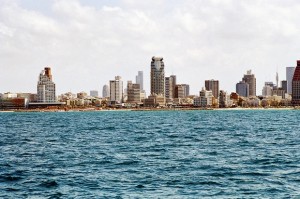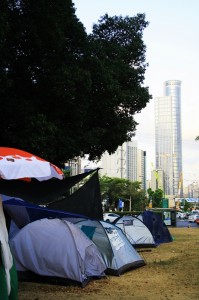Our exclusive report from Tel Aviv tells how the social protest unfolded, what the activists want and how they fight for social justice. One year after the biggest demonstrations in Israel’s history, the movement is divided, confused and striving for new strength.
Moshe Silman, a middle-aged down-on-his-luck man, burns only a few seconds until other social protesters manage to extinguish the flames. With more than 90% of his body severely burned, he slouches on Kaplan Street, Tel Aviv, with a popsicle in his hand, waiting for the paramedics to arrive. One week later after his self-immolation at the rally on July 14th 2012, the first anniversary of the social protest movement, Silman succumbs to his wounds. Prime Minister Binyamin Netanyahu belittles the event calling it a “personal tragedy”, while activists see in it a “wake-up call” and a “national tragedy”. Several “copycats” set themselves on fire because of economic hardship, being largely ignored by the government.
Setting up a tent
July 14th, 2011. Daphni Leef, a 25-year old video editor, sets up tents on Tel Aviv’s expensive Rothschild Boulevard to protest high housing prices. Within weeks, tents spread out to other streets and cities, becoming peaceful party places. The height of the movement is a series of rallies on September 3, where 10 % of the Israeli adult population marches in Tel Aviv and other cities all over Israel, shouting “The people want social justice”.
The government appoints an expert commission that makes some adequate recommendations, which are microscopically implemented and partly contradicted by other recent government measures. The social movement goes into hibernation, which is broadly accepted and rarely challenged. During the winter months, the original founders of the protest split into sparring factions and media coverage moves on. “We could have done much better had we reached a certain continuity”, Yonatan Levi, one of the protest’s initiators, admits later.
The summer of 2012
Expectations were high as the summer of 2012 approached. What eventually happened, was a revitalization of the protests gone wrong. After some poorly covered rallies, Daphni Leef, the symbol of a leaderless protest, suffered an injury to her hand after a scuffle with police on June 22, triggering broad media coverage and a violent rally the following night, with bank windows smashed and about 89 protesters arrested. “The violence took us by surprise, as the relationship with the police had always been flawless”, Levi claimed. “Suddenly the media started drawing a harsh picture of the movement.”
Aggressiveness became an option for the rallies to follow, which confused, disappointed and annoyed many of the supporters of the formerly exclusively peaceful movement. “This is not our social protest anymore, this is not a social protest at all”, said Israel Ben Harush, manager of a café near Netanya whose windows were smashed by protesters. The common goal, social justice, seemed to disappear.
The definition of social justice had always been very diverse among the social activists. Almost everyone had their own idea of what the government should do to bridge social gaps – more government spending, fewer monopolies, more taxes for the rich – the list of suggested remedies was long and contradicting. The slogans were the same, wishing for a return to the welfare state, but the places and the people have been divided since last summer, weakening the protest’s impact. “The social movement has never been homogenic. By now every group has found its niche”, Yonatan Levi said.
The games are over
At the beginning of August, a rally representing a bid to unify the social protest movement and the movement for a universal IDF draft upset many social activists that saw only personal political interests as a driving force of the unity attempt. Among others, Stav Shaffir, one of the initiators, clearly strives for a career in the Labor Party. According to Levi, who has been working closely with Shaffir, “that is just the next step. We need to bring the protest spirit into the Knesset.” Shaffir herself said at the joint rally: “It’s time to go to an all-out war. The games are over.”
She will need to make sure that, with the beginning of this war, the social movement does not die. The numbers of people that invade Israel’s street to protest are slim to none, despite an unpopular series of recent government budget cuts and tax hikes. This year’s protest tent city near Tel Aviv’s Central Train Station is almost empty, the few inhabitants being homeless people.
The new awareness
The public discussion about an attack on Iran has drawn a lot of attention away from the social movement. “It is an old government technique to bring up security issues to silence criticism”, says Levi. “But social justice is by no means less important than missiles.”
That people do not only care about Israel’s security, but also about its social health, is probably the biggest achievement of the social protests. After a disappointing summer with a struggling and confusing movement unable to build on the new awareness of the people, the only thing that has turned out is the realization that social change cannot be measured in terms of summers.
Barbara Engels is a German business journalist, living in Tel Aviv; she is the Israel correspondent of Jewish Voice from Germany


